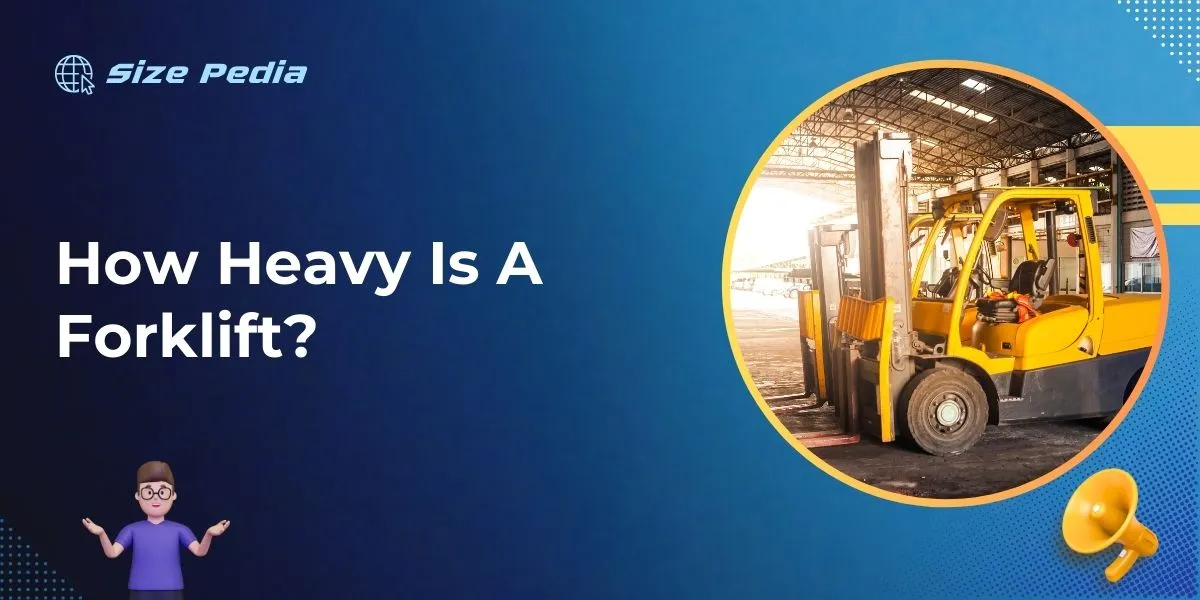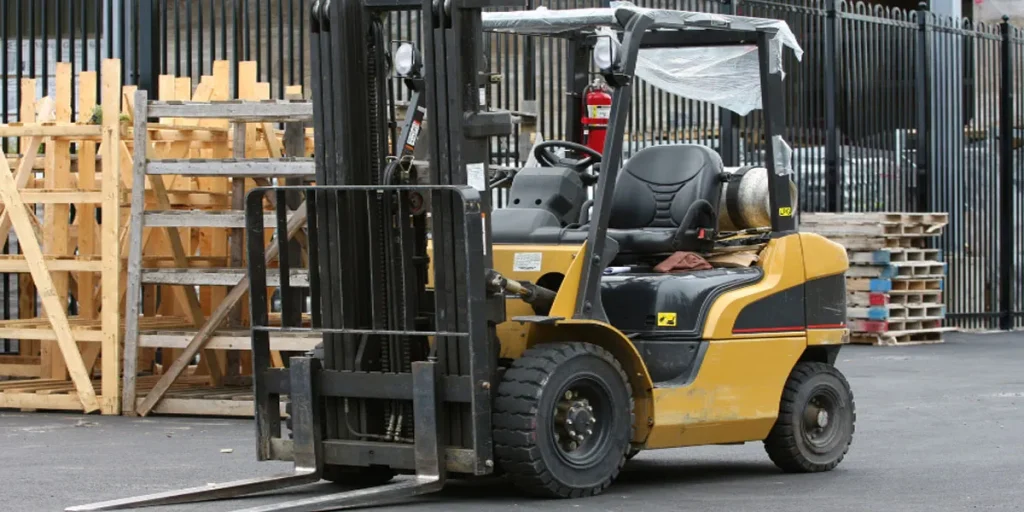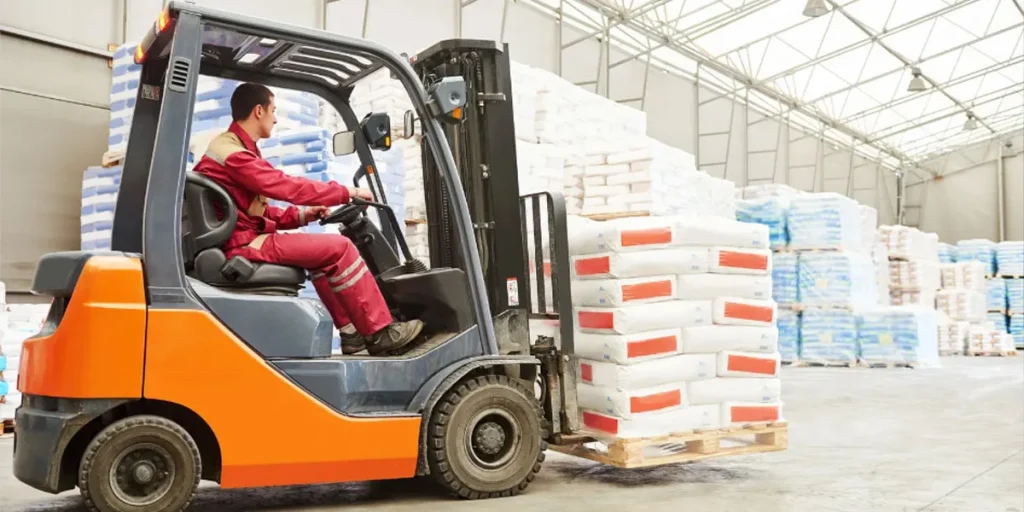The weight of a forklift can vary widely, from as little as 3,000 pounds to over 70,000 pounds. Common warehouse forklifts typically weigh between 3,000 to 9,000 pounds.
A forklift’s heft is integral to its operation, providing a counterbalance for the loads it lifts. Understanding the weight of a particular model is crucial for ensuring workplace safety and determining floor capacity requirements.
Manufacturers design these powerful industrial vehicles to handle heavy materials, and the weight plays a pivotal role in their stability and lifting capacity.
Whether maneuvering through narrow aisles or lifting pallets onto high shelves, forklifts are indispensable in warehousing, construction, and manufacturing environments.
Their weight contributes to the low center of gravity, allowing for safe and efficient transport of goods.
Choosing the right forklift entails considering its weight to match the needs of specific tasks and operational contexts.

Weight Factor Of Forklifts
The Weight Factor of Forklifts is crucial for understanding their operational capabilities and limitations.
The heft of these industrial powerhouses changes across models and applications.
The weight of a forklift affects its lifting capacity, stability, and how it interacts with various workspaces.
Variations According To Forklift Type
Different forklift models serve different purposes. Common types include:
- Pallet Jacks: Range between 500 – 1,000 kg.
- Warehouse Forklifts: Typically weigh 3,000 – 5,000 kg.
- Telescopic Handler Forklifts: Can weigh upwards of 16,000 kg.
- Rough Terrain Forklifts: Usually weigh between 6,000 – 8,000 kg.
Note: The above weights are averages. Individual models may vary.
Factors Influencing The Weight Of A Forklift
Several factors determine a forklift’s weight:
- Capacity: Higher capacity forklifts are heavier.
- Materials: Steel components add significant weight.
- Battery: Electric forklifts increase in weight depending on battery size.
- Attachments: Added features like clamps, rotators add extra weight.
| Capacity | Average Weight Increase |
|---|---|
| 2,000 kg | 3,000 kg total forklift weight |
| 5,000 kg | 7,500 kg total forklift weight |
| 10,000 kg | Over 15,000 kg total forklift weight |
Understanding forklift weight helps ensure proper use in various settings. Always check the manufacturer’s specifications for exact numbers.
Diving Into The Numbers

Understanding the weight of a forklift is crucial for safety and operation. Different jobs need forklifts of various sizes.
Weights can range widely, allowing them to handle diverse loads. Let’s unpack the details and see how much forklifts can weigh.
Average Weights Across Different Models
Every forklift model has a unique weight based on its build and purpose. Small models typically weigh around 3,000 to 5,000 pounds.
Mid-sized ones scale up to about 10,000 pounds. The largest forklifts, designed for heavy work, can exceed 35,000 pounds. Take a look at this table for a clear picture:
| Model Size | Weight Range (lbs.) |
|---|---|
| Small Models | 3,000 – 5,000 |
| Mid-Sized Models | 6,000 – 10,000 |
| Large Models | 10,000 – 35,000+ |
Comparing Light-duty To Heavy-duty Forklifts
Light-duty forklifts are nimble and compact, perfect for small warehouses and light loads.
Heavy-duty forklifts, on the other hand, are powerhouses, designed for construction sites and heavy cargo.
- Light-Duty Forklifts: Generally weigh less than 10,000 lbs and have a lifting capacity up to 5,000 lbs.
- Heavy-Duty Forklifts: Can weigh more than 10,000 lbs and are capable of lifting more than 30,000 lbs.
Selecting the right forklift is all about matching the weight of the machine with the job at hand. Knowing the difference keeps your operations efficient and safe.
Impact Of Weight On Performance
Understanding how the weight of a forklift affects its performance is crucial. It determines not only how much the machine can carry but also how it moves.
Let’s explore why weight matters.
Stability And Load Capacity Correlation
Greater weight in a forklift means more stability. This is vital for lifting heavy loads high up.
A more stable forklift handles larger, heavier materials safer and easier. Here’s how weight impacts load capacity:
- Base Weight: The heavier the base, the less likely the lift will tip over when carrying loads.
- Counterbalance: Extra weight in the back keeps the forklift stable when lifting something heavy in the front.
Manufacturers design each forklift model to handle a specific maximum weight. This ‘rated capacity’ ensures safe operation.
Hence, the design weight affects what and how much the forklift can safely lift.
How Weight Influences Maneuverability?
Weight distribution in forklifts influences how they move. It’s not just about the total weight but where the weight lies.
Forks ahead, counterbalance behind — this design ensures maneuverability. Here’s what happens:
- Heavier Front: Makes it hard to turn quickly. But it’s perfect for moving straight with a load.
- Even Displacement: Helps with sharper turns. No load? The forklift is more agile.
Different tasks require different types of forklifts. Some are built lighter for agility, while others are heavier for stability. Ultimately, weight guides the forklift’s function in your workspace.
Forklift Weight And Workplace Considerations

Understanding the weight of a forklift is vital. It affects many aspects of workplace operations.
From the capacity of the warehouse floor to the stability of the machine, forklift weight plays a crucial role.
Let’s dive into the specifics that businesses must consider regarding the weight of their forklift fleet.
Floor Load Limits And Forklift Operations
Floor load limits are critical when operating forklifts. Exceeding these limits can cause floor damage or worse. Employers must know the weight capacity of their flooring.
- Check building plans or consult an engineer.
- Match forklift weight with floor load limits.
- Consider the weight of loads carried.
Different floors can hold different weights. A table below shows common floor types and their average weights. It’s a guide to help prevent floor damage.
| Floor Type | Average Load Limit |
|---|---|
| Concrete | 25,000 lbs |
| Wood | 1,500 lbs |
| Steel | 50,000 lbs |
Operators must consider these limits during forklift operations. This ensures a safe and efficient working environment.
Role Of Weight In Forklift Safety
The weight of a forklift impacts its stability. Heavier forklifts are generally more stable but harder to stop.
Lighter forklifts can maneuver easier but may tip over faster. Safety is paramount.
- Train staff on weight-related safety.
- Regularly maintain forklifts.
- Check for weight indicators on the forklift.
Operators should know a forklift’s load limit. This ensures the machine doesn’t tip over during a lift. Below is a list of forklift types with their average weights:
- Pallet Jack: Light, great for small loads.
- Warehouse Forklift: Midweight, versatile for many tasks.
- Telescopic Handler: Heavy, for large construction jobs.
Always follow manufacturer guidelines for safe operations.
Remember, safety comes first. Knowing and respecting the weight of your forklift ensures a secure workplace for everyone.
Beyond The Scale
When considering a forklift’s weight, it’s not just about the numbers. Forklifts have evolved into complex machines.
Their design now considers environmental impact. Weight plays a crucial role in this evolution.
Environment-friendly Designs And Weight Reduction
Manufacturers are pushing boundaries to create lighter, eco-friendlier forklifts. Reduced weight means lower energy consumption.
This is crucial for battery-powered models. It extends their operational time and lessens environmental strain.
- New materials: Stronger, lighter metals and composites are in use.
- Smart designs: Components now serve multiple purposes. This cuts down extra weight.
- Energy efficiency: Lighter forklifts use less power, making them greener.
Forklift manufacturers now produce models that are both rugged and light. They do not compromise on performance. These designs also lessen floor damage due to lower pressure.
Future Trends In Forklift Manufacturing
The future shines bright for forklift innovation. Advanced technologies aim to make forklifts even more efficient. Below are trends that will shape the future of forklifts:
- Automation: Self-driving forklifts are on the rise. They promise to increase speed and reduce accidents.
- Electric power: The switch from diesel to electric continues. Electric forklifts promise cleaner operation.
- Connectivity: IoT connectivity in forklifts increases their intelligence. This leads to better fleet management.
Forklifts are set to become leaner, greener, and smarter. These trends will revolutionize materials handling. They will play a significant role in the global push for sustainability.
FAQs About the Weight of a Forklift
What Is The Average Weight Of A Forklift?
The average weight of a forklift can vary widely depending on the model and capacity.
Small forklifts might weigh around 3,000 pounds, while larger models can exceed 50,000 pounds.
It’s essential to know the specific forklift model to determine its exact weight.
How Does Capacity Affect Forklift Weight?
Forklift weight is directly related to its lifting capacity. Generally, a forklift’s weight increases with its ability to lift heavier loads.
For instance, a forklift with a capacity of 5,000 pounds may weigh about 9,000 pounds, ensuring stability and safe operation.
Can Forklift Weights Impact Warehouse Flooring?
Yes, forklift weights can impact warehouse flooring. Heavy forklifts require solid, well-maintained floors to prevent damage.
It’s important to consider the forklift’s weight and the floor load capacity to avoid floor deterioration or safety hazards.
Are There Regulations For Forklift Weight Limits?
There are regulations for forklift weight limits, primarily for safety and compliance purposes.
These limits ensure that forklifts operate within safe weight tolerances, and that operators are aware of maximum loads to prevent accidents or equipment damage.
Conclusion
Understanding forklift weight is crucial for safe operation and optimal warehouse efficiency.
Ranging from 3,000 to 36,000 pounds, these powerhouses support diverse industries. Remember, choosing the correct forklift depends on your specific needs and load requirements.
Keep workplace safety and equipment longevity in mind—knowledge is the key to smart material handling.
